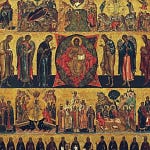Christ is risen!
During Bright Week, there was no fasting; but beginning with the second week after Pascha - or the second week of the Pentecostarion - fasting resumes as normal on Wednesdays and Fridays. The relevant instruction from the Typikon is found in chapter 33:
For the twelve days after the Nativity of Christ, and during the week before Meatfare, and during Bright Week, and the week of Pentecost, monastics are allowed cheese and eggs, laymen - meat.
In other words, only Bright Week is fast-free, after which normal fasting resumes.
Somewhat aside from any spiritual benefits of fasting, it is a discipline. Generally, people become good at what they practice regularly, and tend to be quite bad at things they do only occasionally (except for cases of natural talent or pre-disposition). Those who think that they can fast only during Great Lent, for example, quickly realize - usually in the first or second week - that they are simply not any good at the exercise - even if what is meant by ‘fasting’ is a vegan diet and not actual fasting. In monastic discipline - at least, as far as I understand it from my non-monastic viewpoint - fasting is a way of life, and Great Lent or any other fasting period of the Church fits into this lifestyle in an organic way. Thus, one way to think of the regular fasts during the week is as a preparation for the longer fasts. If Great Lent is a marathon, then fasts on Wednesdays and Fridays are regular work-outs that are necessary in preparation for it. To be sure, there are some who can run a marathon without any preparation, but most cannot.
So, here is a tip: try to establish a fasting lifestyle throughout the whole year. One way to do it, as an example, is to fast every day of the week until noon and until 3 pm on Wednesdays, Fridays, and perhaps also Mondays. Quite apart from what kinds of foods you choose to break the fast, the fast itself simply consists of not eating. This is not unlike the modern fad of intermittent fasting, but the monastic Fathers have been doing this for almost two millennia. Some saints have been known to say that the sun had never witnessed them eating - that is to say, they fasted every day of their life until sunset. Not everyone is called to such discipline, but anyone can fast according to his own measure - whether until noon, or 3 pm, or sunset - each according to his strength.
Last but not least, this is a reader-supported publication; please share it with your friends and family! And if you are saving a lot of money by fasting, please consider becoming a paid subscriber - it is only $5 per month ($4 if you subscribe for a year); and this week, there is a 25% off sale.














Share this post